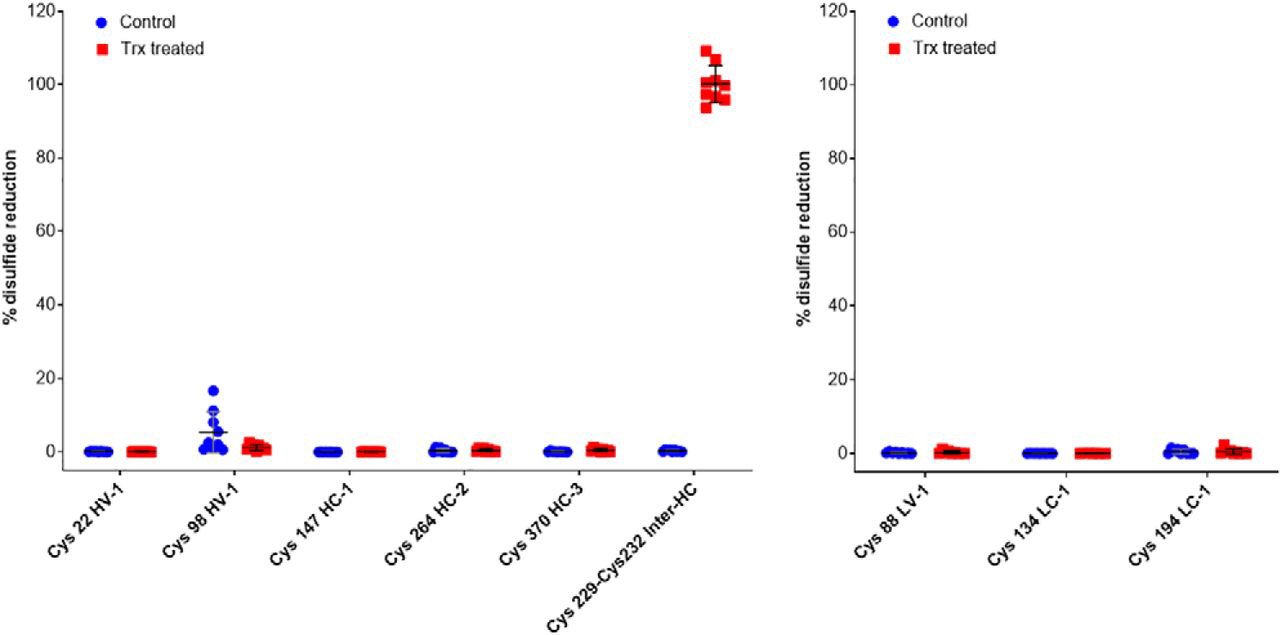Peptide Disulfide Bond Quantitative Analysis Service
- Peptide Drug Development
- Vaccine and Immunopeptide Research
- Protein Folding and Stability Research
- Peptide Quality Control
Peptide Disulfide Bond Quantitative Analysis Service is designed to accurately quantify the disulfide bond content in peptide molecules, reveal the impact of disulfide bonds on peptide structure, folding and function, and provide a scientific basis for the design, development and quality control of peptide drugs.
Peptides play a crucial role in fields such as drug development, biomedicine, and immunology, and the formation and stability of disulfide bonds are vital for the structure, folding, and biological activity of peptides. A disulfide bond is formed by the covalent linkage of sulfur atoms from two cysteine residues and is widely present in peptides and proteins, typically maintaining the stability of their three-dimensional structure. Disulfide bonds not only play an important role in peptide folding and stability, but also significantly influence peptide interactions with other molecules, such as ligands, receptors, and metal ions. Accurately detecting and quantifying disulfide bonds in peptides is key to optimizing peptide structure, enhancing biological activity, and developing novel drugs.
Leveraging advanced chromatography and mass spectrometry platforms, MtoZ Biolabs provides Peptide Disulfide Bond Quantitative Analysis Service to precisely analyze the disulfide bond content in peptides, helping researchers gain a deeper understanding of the structure-function relationship of peptide molecules, enabling the optimization of their applications in biomedicine.
Analysis Workflow
The general process for Peptide Disulfide Bond Quantitative Analysis Service is as follows:
1. Sample Preparation
Perform purity testing, confirm concentration, and adjust the buffer conditions of the peptide sample as necessary.
2. Sample Treatment and Reduction
Use reducing agents (such as DTT or TCEP) to reduce disulfide bonds, or select untreated samples for analysis.
3. LC-MS/MS Analysis
Utilize liquid chromatography to separate the peptide sample, followed by mass spectrometry for qualitative and quantitative analysis of disulfide bonds.
4. Data Analysis
Process and analyze the data to obtain quantitative information on the disulfide bonds.
5. Report Generation
Provide a detailed experimental report that includes experimental methods, mass spectrometry parameters, disulfide bond quantitative analysis results, and data spectra.

Gurjar SA. et al. J Biol Chem. 2019.
Figure 1. Quantitative MS showing the percentage reduction of each disulfide bond of infliximab after treatment with Trx.
Service Advantages
Advanced Analysis Platform: MtoZ Biolabs established an advanced Peptide Disulfide Bond Quantitative Analysis Service platform, guaranteeing reliable, fast, and highly accurate analysis service.
One-Time-Charge: Our pricing is transparent, no hidden fees or additional costs.
Comprehensive Disulfide Bond Information: Not only can the quantity of disulfide bonds be quantified, but the oxidation-reduction state and other related information can also be revealed.
Flexible Experimental Plans: Customized experimental designs and flexible technical support are provided based on the peptide's characteristics and research needs.
Sample Submission Suggestions
Sample Types: Supports synthetic peptides, naturally sourced peptides, recombinant expressed peptides, etc.
Storage and Transportation: Store at low temperatures (−20°C or −80°C). Dry ice transportation is recommended to avoid repeated freeze-thaw cycles.
Additional Notes: We recommend contacting us prior to sample submission for detailed and tailored sample preparation guidelines.
Applications
Examples of applications for Peptide Disulfide Bond Quantitative Analysis Service:
Analyze the disulfide bond content and stability in peptide drugs, providing scientific evidence for stability optimization, folding studies, and enhancing biological activity.
Analyze the disulfide bond content in antigen peptides to help understand their role in immunogenicity and immune response.
Quantify disulfide bonds to reveal protein folding states and stability, particularly changes under different environmental conditions.
Ensure the integrity of disulfide bonds in peptide formulations, monitor peptide quality and purity, and ensure product consistency and stability.
Deliverables
1. Comprehensive Experimental Details
2. Materials, Instruments, and Methods
3. Total Ion Chromatogram & Quality Control Assessment (project-dependent)
4. Data Analysis, Preprocessing, and Estimation (project-dependent)
5. Bioinformatics Analysis
6. Raw Data Files
Related Services
Disulfide Bond Analysis Services
How to order?







